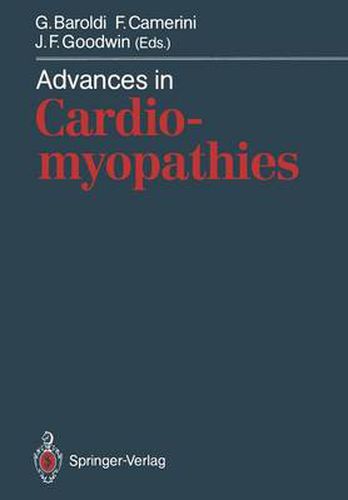Readings Newsletter
Become a Readings Member to make your shopping experience even easier.
Sign in or sign up for free!
You’re not far away from qualifying for FREE standard shipping within Australia
You’ve qualified for FREE standard shipping within Australia
The cart is loading…






This title is printed to order. This book may have been self-published. If so, we cannot guarantee the quality of the content. In the main most books will have gone through the editing process however some may not. We therefore suggest that you be aware of this before ordering this book. If in doubt check either the author or publisher’s details as we are unable to accept any returns unless they are faulty. Please contact us if you have any questions.
The international symposium organized by the Italian Study Group on Cardiomyopathies (SPIC) and planned by the organiz- ing and scientific committees opened with a review of the history of cardiomyopathy over the last 30 years by Goodwin, London (UK) and continued with presentations on all aspects of hyper- trophic and dilated cardiomyopathy by a wide spectrum of inter- national experts. This book includes mainly the invited contributions, but there are also many original oral presentations. Hypertrophic cardiomyopathy is well addressed by papers on natural history, ventricular function, ischaemia and arrhythmia. Of particular interest is the note by Bonow, National Heart Lung and Blood Institute (NHLBI; USA), on the effect of beta-adrenergic stimulation with isoprenalin in increasing the rate and extent of left ventricular relaxation, beta-adrenergic blocking agents having no such effect. In contrast, verapamil improves ventricular relaxation as would be expected. These results challenge accepted belief in some ways and indicate that multiple factors - both passive and active - acting on the left ventricle, such as ischaemia, asynchrony, altered left ventricu- lar loading and intracellular levels of calcium ions, are all oper- ating. These aspects are the more interesting in view of the recent reports of an increase in calcium-channel receptors, but not in beta-adrenergic receptors, in hypertrophic cardiomyo- pathy.
$9.00 standard shipping within Australia
FREE standard shipping within Australia for orders over $100.00
Express & International shipping calculated at checkout
This title is printed to order. This book may have been self-published. If so, we cannot guarantee the quality of the content. In the main most books will have gone through the editing process however some may not. We therefore suggest that you be aware of this before ordering this book. If in doubt check either the author or publisher’s details as we are unable to accept any returns unless they are faulty. Please contact us if you have any questions.
The international symposium organized by the Italian Study Group on Cardiomyopathies (SPIC) and planned by the organiz- ing and scientific committees opened with a review of the history of cardiomyopathy over the last 30 years by Goodwin, London (UK) and continued with presentations on all aspects of hyper- trophic and dilated cardiomyopathy by a wide spectrum of inter- national experts. This book includes mainly the invited contributions, but there are also many original oral presentations. Hypertrophic cardiomyopathy is well addressed by papers on natural history, ventricular function, ischaemia and arrhythmia. Of particular interest is the note by Bonow, National Heart Lung and Blood Institute (NHLBI; USA), on the effect of beta-adrenergic stimulation with isoprenalin in increasing the rate and extent of left ventricular relaxation, beta-adrenergic blocking agents having no such effect. In contrast, verapamil improves ventricular relaxation as would be expected. These results challenge accepted belief in some ways and indicate that multiple factors - both passive and active - acting on the left ventricle, such as ischaemia, asynchrony, altered left ventricu- lar loading and intracellular levels of calcium ions, are all oper- ating. These aspects are the more interesting in view of the recent reports of an increase in calcium-channel receptors, but not in beta-adrenergic receptors, in hypertrophic cardiomyo- pathy.